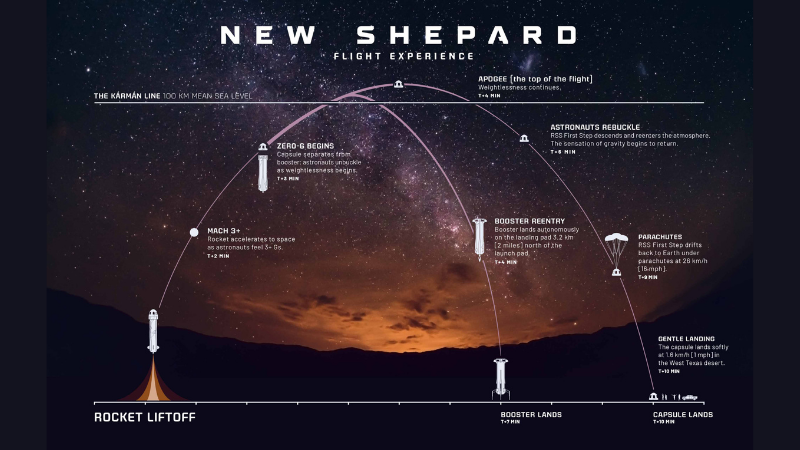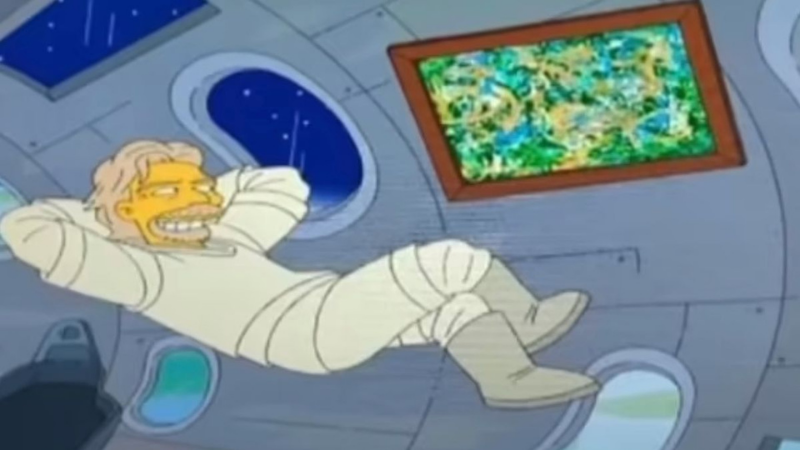



Jeff Bezos’ big space adventure
The TLDR: The world’s richest man traveled to the boundary of space—in the company of three other astro-tourists—and made it back in one piece. Is this really such a big deal or just billionaire vanity as usual?
First, tell me about the flight
The passengers: We’re not going to bother introducing Bezos, but here’s who he traveled with:
- Wally Funk. In 1961—three years before Jeff Bezos was born—she and 12 other women entered a privately funded Woman in Space Program, designed to see if it was possible to send women into space. But the program was shut down, and she never made it into space… until now. At 82, she is now the oldest person to travel to space.
- Oliver Daemen. An 18-year old high school graduate, he is the son of Joes Daemen, CEO of an investment firm based in the Netherlands. No one knows how much daddy paid for the ticket. But we do know that Oliver follows Elon Musk on Twitter, not Bezos.
- Mark Bezos. He is Jeff’s chota bhai and BFF. He’s worked in marketing, advertising and equity; served on the boards of various philanthropic organisations; and is a volunteer firefighter.
The rocket ride: Here’s how this space trip went down.
- At 8:12 am local time in West Texas, Bezos’ rocket called New Shepard went straight up in space—at about 2,300 miles/hour, which is three times faster than the speed of sound.
- After about three minutes, the crew capsule—carrying four passengers and zero crew—separated from the rocket, which came back down.
- Bezos & Co experienced about three to four minutes of weightlessness during which the spacecraft reached the top of its flight path—66.5 miles above Earth.
- Then it came back down, gliding on parachutes as it reentered the atmosphere, and landed gently on the ground.
- The entire trip lasted 11 minutes. That’s it.
The flight path: Looked something like this:

The livestream: was fairly uneventful. Here’s the lift off—where the most notable bit was the, umm, shape of the rocket:

And here’s the landing:
No, Jeff didn’t send any selfies from space, except this one of his left arm:

Didn’t Richard Branson do it first?
Yes and no. It depends on how you define ‘space’. Nine days ago, the Virgin Galactic founder flew out with two pilots and a handful of company execs on the VSS Unity spaceplane. But he only flew to an altitude of 53 miles (88 km) above Earth. OTOH, his flight lasted a whopping 59 minutes from takeoff to touchdown.
Where does space begin? Branson flew into space if we accept the boundary of space as recognised by NASA and the US Federal Aviation Administration—which is 80 km out. But Fédération Aéronautique Internationale (FAI)—which maintains standards for aeronautical activities—defines the boundary at 100 km (62 miles) aka the Kármán Line. And Blue Origin has been trolling Branson even before he blasted off, claiming it flies higher than Virgin Galactic, “so none of our astronauts have an asterisk next to their name.” But the reality is that there is no internationally accepted definition of where space begins. But here’s what’s important: Neither of them went far enough to achieve orbit around Earth.
Point to note: Countries like the United States are not keen on reaching an international consensus, according to astrophysicists:
“The U.S. has resisted there being any international agreement… because they don’t want space to be too clearly defined. Because then it becomes obvious that their missiles go through space and might potentially be subject to space law. The general idea is that the U.S. [military] has more freedom of action if it’s not defined.”
But drawing that line is suddenly very important. That’s because billionaires need their bragging rights—and because they plan to make money off other very rich people who don’t want any doubt about their astronaut cred.
Branson for the win? Space boundaries apart, Branson’s space voyage was the stuff of pop culture prophecy—predicted by The Simpsons back in 2014.

Is space tourism for real?
Yes, if you are insanely rich—at least for now. And that’s the point of both Bezos’ and Branson’s flights. These are massively expensive PR spectacles designed to send the message ‘This is super cool and super safe’. But most mere mortals will not be able to take that super cool, super safe ride, as The Verge notes:
“To live their own version of Branson’s dream, customers will have to pay at least $250,000 for a seat (the company already has roughly 600 booked passengers). And right now, the quarter-million-dollar price tag is the cheapest option on the market. The price for a seat on Blue Origin’s New Shepard rocket could be higher. And if you want to go into orbit for a few days, a ride on [Elon Musk’s] SpaceX’s Crew Dragon capsule will set you back at least $55 million (that could be higher too; SpaceX hasn’t publicly confirmed the real price).”
OTOH: Almost every amenity we now take for granted—be it owning a car or a computer, or flying on a plane—started out as an uber-luxury. Back in 1943—when computers took up entire rooms—the chairman of IBM dismissively said, “I think there is a world market for maybe five computers.” Investment analysts estimate that tourism to suborbital space could be an $8 billion industry by the end of the decade. And as this Washington Post op-ed argues:
“[S]uch flights are a great platform for the kind of incremental innovation that eventually transformed Orville and Wilbur Wright’s motorized box kite into a Boeing 737, and Karl Benz’s gasoline-powered tricycle into a sleek C-class. That is the kind of innovation that private entities tend to do better than government—in no small part because private entities face more continuous competitive pressures to go a little farther, a little faster, a little more comfortably. If humanity is eventually going to the stars, that kind of innovation will be an essential part of how we’ll get there.”
Hmm, but is space tourism a good thing?
That’s a very different question. And here are two good reasons why critics say we shouldn’t be celebrating Bezos or Branson.
One: The argument for spending on space technology is that it contributes to human understanding—and spurs technological innovation here on Earth. For example: GPS in your smartphone. But this has been true of publicly funded projects steered by governments, not extremely expensive tourist traps designed to enrich billionaires. And as one technology historian puts it:
“The experience of a few hyper-wealthy amateurs paying $28 million to vomit for 15 minutes probably won’t bring many average people closer to spaceflight or change their impression of it… Compared to NASA’s space vehicles, they are clever amusement park rides with minimal utility, intended to support a tourism business that has never been part of NASA’s charter.”
Two: If space tourism were to really take off, it would likely be a disaster for a planet already buckling under the weight of climate change. As one climate scientist points out:
“The Virgin Galactic flight carried six passengers and reached an altitude of 53 miles [85.3 kilometers], and from information provided by Virgin Galactic, we can estimate that carbon emissions per passenger mile are about 60 times that of a business class flight.”
Now, one can argue that since space tourism will remain a super-niche industry, its eco-footprint will be relatively small. But the whole point of these PR exercises is to change that—to “open space to everyone,” as Branson puts it.
Point to note: The super-wealthy are already super-polluters: individuals in the richest 1% are responsible for 175 times more greenhouse gas pollution than the average person in the bottom 10%. Space tourism will increase that impact even further:
“When you look at the aviation sector, private jets are so much worse on a per passenger basis than a regular plane full of economy class passengers just because fewer people are traveling on each one. You put just one or two people in a rocket, and you’ve got something orders of magnitude worse that would supersize the carbon footprints of people that already have the largest ones.”
The bottomline: We hate to be space party poopers but we tend to agree with the grumpy US Senator Bernie Sanders on this one:
“Here on Earth, in the richest country on the planet, half our people live paycheck to paycheck, people are struggling to feed themselves, struggling to see a doctor—but hey, the richest guys in the world are off in outer space!”
Reading list
- Cnet has a good overview with reactions from the four-person party crew.
- Gizmodo has the best take on the impact on climate change.
- The Verge looks at whether space tourism can ever become a business for the mass market.
- New Yorker points out that the real action in space is happening elsewhere—driven by countries like China.
- This Washington Post op-ed makes a strong case for the billionaire space race.
- National Geographic has a lovely gallery of photos marking the historic moments of animals and humans flying to space
- You can learn more about Wally Funk in this New York Times profile—or read The Atlantic’s take on the unusual crew.
- Also in The Atlantic and CNBC: Where does space begin?
- CNN assesses which billionaire is ahead of the space race right now.
- Reuters’ video report looks at which space flight was cooler: Branson or Bezos?

 souk picks
souk picks